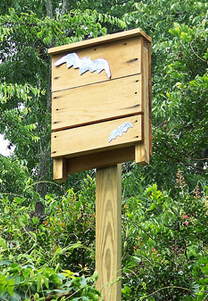
Large Nursery Box
Photo by: Calvin Butchkoski, Pennsylvania Game Commission
Bat Boxes do Work!
Just check out the photo above, snapped by biologist Cal Butchkoski of the Pennsylvania Game Commission, of a bat box in Pennsylvania chock full of bats!!
Putting up a bat roosting box can help replace lost or degraded habitat that has been contributing to the decline of bat populations throughout North America. Bats in Maryland that are likely to inhabit bat boxes include Little Brown Bats, Big Brown Bats, Northern Long-eared Bats, and Evening Bats.
You can increase your chances of successful occupation by keeping in mind the following criteria recommended by Bat Conservation International’s Bat House Research Program:
Design –
Outside dimensions of houses should be about 2 feet tall and at least 14 inches wide with a 3-6 inch landing area.
Roost partitions should be ¾” to 1”.
Ventilation slots should be ½” wide.
Construction –
Half inch plywood is best for fronts, backs and roofs, and roosting partitions.
1” board lumber is best for sides.
Prior to painting all seams should be caulked with latex caulk that remains flexible over time.
Paint exterior surfaces with two coats of exterior latex paint (dark brown, dark gray or dark green is best for Maryland).
Sun Exposure –
Boxes should receive at least 6-7 hours of direct sun
In Maryland, boxes should be oriented southeast or southwest.
Box should be within ¼ mile of water (stream, river or lake) with a mixture of different habitats (forest, agriculture)
Locate 20-25 feet from the nearest trees
Mounting –
Uninvited Guests –
Open-bottom designs are less likely to be occupied by birds, mice, or squirrels.
Paper wasps may build nests in partitions > ¾”. Mud daubers are seldom aggressive and have weak stings.
Nests of both species can be knocked down in spring with a high pressure water hose.
Bat Box Plans
-
Small Economy Bat Box Plans - Use this plan if you don't know what kind of bat populations are in your area. It is small, easy to construct, and does not require a large investment in time and materials. If you are successful in attracting bats, you can keep this box and add a 2-Chamber Rocket Box or a Large Nursery Box.
-
Two-Chamber Rocket Box Plans - This is an experimental design from Bat Conservation International. It is easier to construct and erect than the large nursery box. If you decide to build this bat box, please report results to Bat Conservation International in the fall to help them evaluate this design.
-
 14-Chamber Aluminum Box Plan - The success of bat boxes has opened up a new dilemma. All wood structures require maintenance. To reduce maintenance concerns, research is focusing on methods to make boxes more durable. The aluminum shell is a step in that direction. This design has proven successful in recent trials. The design uses an aluminum shell, although steel would likely work too. The advantage of using aluminum is that it resists corrosion and should last a long time. This plan is provided courtesy of the Pennsylvania Game Commission.
14-Chamber Aluminum Box Plan - The success of bat boxes has opened up a new dilemma. All wood structures require maintenance. To reduce maintenance concerns, research is focusing on methods to make boxes more durable. The aluminum shell is a step in that direction. This design has proven successful in recent trials. The design uses an aluminum shell, although steel would likely work too. The advantage of using aluminum is that it resists corrosion and should last a long time. This plan is provided courtesy of the Pennsylvania Game Commission.
-
Large & Small Nursery Boxes - Pictured above, the Large Nursery Box is designed for use in areas where bat populations are high. When bats are excluded from homes, this is the recommended box to construct. Plans also feature a Small Nursery Box. Both are provided courtesy of the Pennsylvania Game Commission.
-
Sources for Bat Roosting Boxes - If you would like to purchase a bat box kit or an already-built bat box, here are several resources to explore.
Got Bats?
 Got Bats?
Got Bats?
Have you seen bats at your house or in your neighborhood? Bats are commonly misunderstood but extremely important animals in Maryland. Unfortunately, bats in Maryland and in much of the United States are in decline. We would love to know more about Maryland's local bat roosts to assist with their conservation! To help out, please fill out our
Bat Roost Reporting form.
Photo of Bat House by SFAJane Flickr CC by 2.0